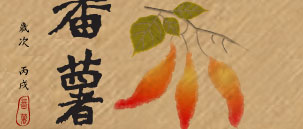





|
|
| |
Dr. Jin-Long Li, former Chairman, the Commission of Agriculture, the Executive Yuan.
|
|
| |
|
|
|
| |
On the day of celebrating the 110th anniversary of the Agriculture Experiment Institute, the Executive Yuan, we were lucky to be able to attend the great celebration through the staff’s arrangement. During the occasion, we met Dr. Jin-Long Li, the then Chairman of the Commission of Agriculture, the Executive Yuan. He was very happy to receive us. Besides the interactive conversation, he also introduced us – the little sweet potato soldiers from Bin-Jiang Junior High School to the respected elderly farming experts at present. |
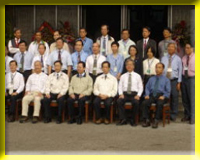
The farming expoerts around the island attended the 110th anniversary of the Agriculture Experiment Institute
|
|
|
| |
| |
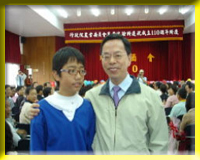
Dr. Jin-Long Li, former Chairman, the Commission of Agriculture, the Executive Yuan, encouraged us greatly!
|
Dr. Jin-Long Li, the former Chairman of the Commission of Agriculture, delivered a speech mentioning that a lot of children living in the city had no idea at all of the origins and sources of crops. Thus, to hold a “Farmers’ Day” enabling people aware of the achievement that the Agriculture Experiment Institute was meaningful. Exploiting Taiwan’s being a natural greenhouse, the Agriculture Experiment Institute has been dedicated to research and improvement on various crops, using the farming technology of a tropical country to predominate the farming markets of temperate-zone countries. It again evidences Taiwan’s spirit of "Agriculture is the foundation of the nation". |
|
|
| |
| |
Besides, to promote the development of bioblast energy by using certain crops, the Commission of Agriculture, the Executive Yuan, held 「the National Energy Conference」 in June, 2005. It was estimated to promote 1-million to 3-million liters of gasoline alcohol in the year 2010, 2-million to 6-million liters of gasoline alcohol in the year 2015, and 3-million to 9-million liters of gasoline alcohol in the year 2020. The crops used in developing this kind of energy are mainly sugar-contained and starch crops, which include sweet potato, sugar cane, corn, sorghum, sugar beet, etc. Ssweet potato and sugar cane have been assessed as the most suitable crops to be used in developing this bioblast energy. |
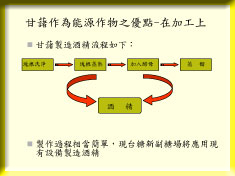
Sweet potato has been assessed as the most suitable crop for developing bioblast energy
|
|
|
| |
| |
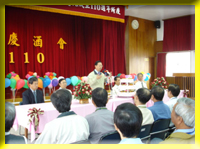
Dr. Jin-Long Li, former Chairman, the Commission of Agriculture, the Executive Yuan, delivered a speech in the anniversary party
|
In the past, the general image of agriculture on people was merely an industry for providing food. In fact, the research of bioblast energy has concluded that plants can be used to transform solar, water, and CO2 energies into bioblast energy. There are a lot of fallows each year in Taiwan, which can be used to promote bioblast energy crops, develop bioblast energy, and elevate agriculture’s “Green produce value”. This will give rise to the new development opportunity of Taiwan’s agriculture. |
|
|
| |
| |
|
| |
| |
| |
Interview with Dr. Yong-Chang Lai, Jia-Yi Branch, the Agriculture Experiment Institute
|
|
| |
|
|
|
| |
We made use of a certain weekend to go down to Jia-Yi Branch of the Agriculture Experiment Institute and asked Dr. Yong-Chang Lai in charge of sweet potato breeding and genetics many questions. Dr. Lai provided us many precious materials, and showed us many species of sweet potato in the farm. Because of the confidential nature of the country’s agriculture, people from outside are prohibited to enter the Institute unless being accompanied by its staff. |
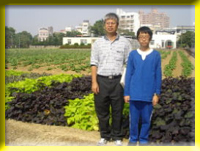
Dr. Lai toured us around the sweet potato farm and expliained about different species.
|
|
|
| |
| |

Dr. Lai’s research achievement was also reported by the media.
|
The recent research achievement that Dr. LAI made was to assist the farmers in Da-Cheng Xiang, Zhang-Hwa County, to set up a management flowchart of breeding sweet potato, from land reclaiming and forming, planting, categorizing and sacking, to shipping. By doing so, farmers were able to produce sweet potato that meets the standard of agrochemical remains. Consumers may enjoy eating sweet potato with any concern and thus the good reputation of Taiwan’s sweet potato can be built up. |
|
|
| |
| |
According to Dr. Lai, we were the youngest in all the groups that had ever consulted him. Most of the persons approaching him for advice were graduate students. Nonetheless, Dr. Lai didn't treat us in a perfunctory way because of our age. On the contrary, he provided us many materials regarding his researches and lectures. These hard-to-get materials really helped us a lot. Encouraging ourselves to work even harder and harder was the only thing we can reciprocate him. |
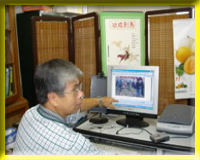
Thank Dr. Lai for providing his research reports that greatly benefited us.
|
|
|
|
| |
|
| |
| |
| |
"Uncle Sweet Potato", Bei-Pu Xiang, Xin-Ju County
|
|
| |
|
|
|
| |
Guided by the voluntary mamas, we came to a farm named “Uncle Sweet Potato Roasted Kiln” in Bei-Pu Xiang, Xin-Ju County. As arranged by the farm owner, we visited Uncle Sweet Potato, the 70-year-old Mr. Zhuang. He received us with kindness, fully displaying an elderly person’s temperament. We respected him very much. Here below is the interview summary.:
Question:What is the best farmland for planting sweet potato?
Answer:The most important is the place where the sun can shine in. Good drainage is also required.
Question:Can sweet potato be planted at any time?
Answer:It depends on species. Generally speaking, there are two harvests in a year. The first one must be harvested after 150 days, the second one must be harvested after 120 days due to warmer weather.
Question:What should one pay special attention to during planting?
Answer:At the beginning of planting, the seeds should be infused with water within 2 or 3 weeks, otherwise the insect will bite them. Also, we have to loosen the seed to prevent the wild caulis from hindering the growth of sweet potato.
Question:How do you harvest sweet potato?
Answer:The southern Taiwan has wider planting ground, and the farmers there currently use machinery to harvest. The northern Taiwan has relatively smaller planting ground, and thus the farmers there use cattle to plough and harvest. While harvesting, farmers have to divide sweet potato into three categories, big, medium-sized, and small. The big ones will be purchased by distributors and then be sold to the stores or be made into cakes or desserts. The medium-sized ones are used by roasted kilns, whereas the small ones are used to feed pigs, chickens or ducks.
Question:How many yields are there per seed?
Answer:Take Taoyuan No.1 for instance. The sweet potato planted before autumn is bigger. Each seed can not yield many pieces, say about 3 to 4 pieces. The sweet potato planted after autumn is smaller, but with bigger quantity. Each seed may yield as many as more than 10 pieces.
Question:Are all the present species the same as the original ones?
Answer:No, no, no. Farmers have improved almost each and every species. I myself was the leader of the first class of sweet potato distribution course of Bei-Pu Xiang. Taoyuan No.1 is the species improved by Bei-Pu Xiang. There were no species serial numbers available before the restoration of Taiwan. After Taiwan’s restoration, there have been numerous improved species and they have to be numbered. As for usage, sweet potatoes in different places are not necessarily the same. It depends on the demand. Some sweet potatoes are sweet and juicy, but they are too soft to roast kiln nor can they be made into cakes. Taoyuan No. 1 is hard and sweet enough, suitable for roasted kiln.
Question:What is the difference between now and the past regarding planting method?
Answer:They are totally different! Sweet Potato's planting in the past was completely done by hand; loosening soil and grow seeds all relied on cattle and man labor. The planting or the harvesting of today’s farmland is using machinery. It’s a much easier job now compared to the past!
Question:How will sweet potato be if running into natural calamities?
Answer:If inundation due to typhoon continues for over two days, sweet potato would get rotten. If encountering draught, sweet potato will be bitten by insects and as a result won’t be harvested.
Question:When did Uncle Sweet Potato move to Bei-pu? Can you describe the situation at that time?
Answer:My father has lived here since the Japanese occuptation period. Prior to Taiwan’s restoration, I was about 9 years old. We had no rice at that time, sweet potato was our major food. Being afraid of causing fire and also afraid of the roasted sweet potatoes being stolen, we had to be very discreet in roasting the kiln. In view that rice could not be harvested due to constant air raids and gunfire, sweet potato became the major food of each family.
Question:How did the farm change to the present business mode?
Answer:As the farmers of earlier generation were getting older and most young people moved out to make their living, the agricultural society gradually declined and crops were getting less and less. Meanwhile, the government also successively allowed some crops and rice to import from abroad. Considering the local crops’ economic effect and their competitiveness in future, the government encourages farmers to transform their business modes. So, this farm began to transform its business mode under the assistance of the Commission of Agriculture, the improvement fields, and the Agriculture Association of Bei-Pu Xiang in 1998. This farm was run by me alone for the first two years. Starting from the third year when the business got better, I asked my son and my daughter-in-law come back to help me. Thanks to young people’s abilities of using Internet and beautifying packaging, we have achieved a great deal as it is now.
Question:Are the farmers planting sweet potato getting less? How is its economic value?
Answer:Farmers who plant sweet potato are indeed getting fewer, but its economic benefit is quite good. In the past, it was planted to feed pigs. Nowadays, it is sold to people with good margins. Generally speaking, the elder people seldom do exercise; therefore it’s easy for them to get constipation. Sweet potato has abundant fiber, it can accelerate bowel peristalsis and facilitate digestion. To eat sweet potato once a day will help your bowel movement. It’s also reported in the newspapers and magazines that eating sweet potato can prevent cancer and it’s even better to eat with peel.
Question:What’s the origin of kilns?
Answer:There are two kinds of kilns: one is the traditional soil kiln, the other is brick kiln. Ever since the Japanese occupation period, people always used soil kilns. Upon rice harvesting of the second time, farmers ploughed the land pulled by cattle to loosen the soil and dug out the harder mire. The soil became harder after drying in the air that could be used to build kilns. The fun and the experience associated with burning and opening kilns cannot be surpassed by modern brick kilns. Because brick kilns are ready-made, one cannot experience the pleasure of building kilns. However, it’s easier to roast kilns by using brick kilns. There are about six kiln farms in Bei-Pu Xiang that use soil kilns. You are most welcome to visit these kilns. |
|
|
| |
| |
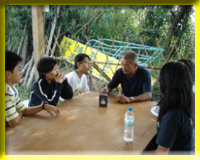
Uncle Sweet Potato demonstrates the elderly person’s temperament
|
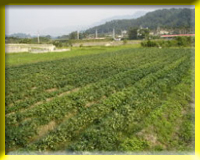
Good farm is key to planting sweet potato
|
|
|
| |
| |
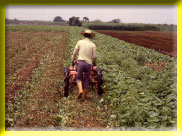
In southern Taiwan, the planting area is bigger and farmers currently use machinery to harvest
|
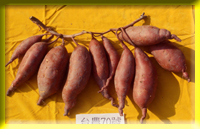
Tai-Agri No.70 is the species planted in autumn
|
|
|
| |
| |
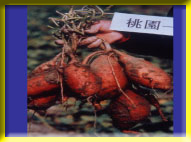
The improved species of Taoyuan No.1
|
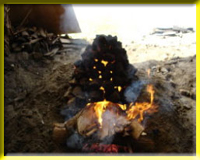
The traditional soil kilns inspire us to think of the old days
|
|
|
| |
| |
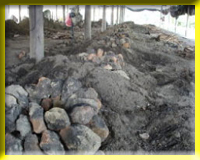
During the Japanese occupation period, people had to be very discreet when roasting kilns
|
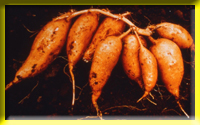
The abundant fiber contained in sweet potato can accelerate bowel peristalsis
|
|
|
| |
| |
|
| |
| |
| |
Mr. Wan-Chin Li, the Directive Staff of the Agriculture Association of Xe-Hu Xiang
|
|
| |
|
|
|
| |
We attended 2005 Xi-Hu Sweet Potato Culture & Art Festival in Miao-Li on November 19th, 2005, and visited Mr. Wan-Chin Li who was the directive staff of Xi-Hu Farmers’ Association and the host of the said activity. Mr. Li told us that Xi-Hu Xiang started to hold the Sweet Potato Culture & Art Festival four years ago. Xi-Hu Xiang is a small village situated in the hilling area with a population of 8296. Farmers take turns in planting paddy rice and sweet potato. Because of its poor sales ability, sweet potato could not be sold to other places. To increase the popularity of Xi-Hu’s crops, they began to hold “Xi-Hu Sweet Potato Culture & Art Festival”. |

Mr. Wan-Chin Li, the directive staff of Xi-Hu Xiang’s Farmers’ Association
|
|
|
| |
| |
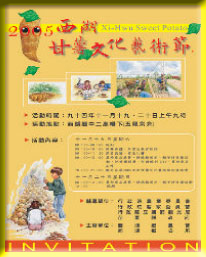
Xi-Hu Sweet Potato Culture & Art Festival
|
Xi-Hu's crops such as sweet potato have gained top-notched reputation after these years' efforts. This year's focus of “Xi-Hu Sweet Potato Culture & Art Festival" is “Sweet Potato 1, Sweet Potato 2” with the purpose of introducing Xi-Hu sweet potato to consumers.
There are many processed food in Xi-Hu. The most attractive one is “Ice Sweet Potato” that was a creative product as a result of farmers’ creative development and artistic packaging. It is not only delicious, but also a model of creative cultural industry. Ice Sweet Potato is a processed food made of Tai-Agri No. 5 sweet potato. Other processed food from sweet potato, like fresh sweet potato, sweet potato stick, sweet potato shake, sweet potato balls, sweet potato vegetable bowl and sweet potato ice bar are made of Taoyuan No.1.
|
|
|
| |
| |
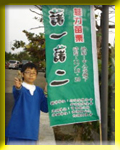
As for the knowledge about sweet potato, we are also top-notched!
|
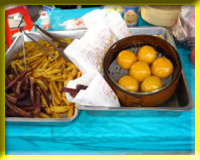
The various processed food made of Taoyuan No.1 sweet potato
|
|
|
| |
| |
|
|
|
|
|
